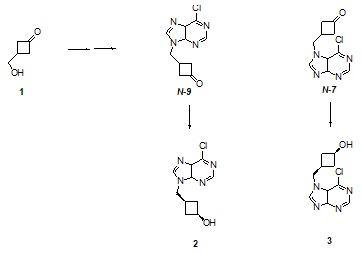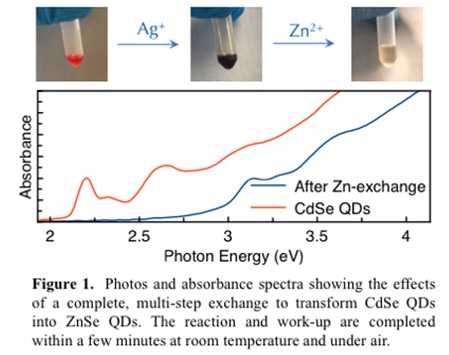Day 1 :
Keynote Forum
Edward Lee Ruff
York University, Canada
Keynote: Preparation of novel nucleoside analogues from cyclobutane precursors as potential antiviral agents
Time : 00:00-00:30

Biography:
Abstract:
Cyclobutanes represent strained compounds which exhibit chemical reactivity not encountered with unstrained ring systems. These properties have been exploited in their capacity as synthetic intermediates. Cyclobutane nucleosides as oxetanocin analogs have been shown to exhibit antiviral and other biological activities.1 Our interests in cyclobutanone chemistry has prompted investigations into the preparation of novel cyclobutane nucleoside analogs. We report in this paper the synthesis of novel cyclobutanols 2 and 3 from its precursor 1. The coupling of 6-chloropurine with 1 gives two regioisomers consisting of the N-9 and N-7 ketones with the latter formed as the major product.. These were selectively reduced using a hindered hydride donor to

Keynote Forum
P. Gregory Van Patten
Middle Tennessee State University, USA
Keynote: Developing cation exchange as a viable strategy for nanoparticle synthesis
Time : 00:00-00:30

Biography:
Dr. Van Patten is Professor and Chair of Chemistry at Middle Tennessee State University specializing in the study of semiconductor quantum dots (QDs). His recent focus has been the study of cation exchange as a means to access new types of QDs that are challenging or impossible to synthesize by more direct routes. In the past, Van Patten has also studied QD self-assembly in solution, resonance energy transfer between QDs, and ultrafast photophysics of QDs. After earning his Ph.D. in Chemistry at the University of South Carolina, Van Patten served as a postdoctoral associate at the Los Alamos National Laboratory, studying the light harvesting properties of polymer films impregnated with metalloporphyrins and related dyes. His work has produced over 40 publications and 2 patents. In 2008, he was awarded a Research Fellowship by the Alexander von Humboldt Foundation.
Abstract:
Semiconductor quantum dots (QDs) are promising materials with interesting, size-dependent properties. Although a few model systems (CdSe, PbS, and some others) have been developed, optimized, and thoroughly studied over the past few decades, there remain several obstacles that prevent their adoption in a variety of applications. One principal challenge is the inability to access a diverse range of QD materials with excellent control over size, shape, crystallinity, and surface chemistry. Control over these QD characteristics is crucial for the production high quality materials. Since direct synthetic approaches that afford such control have been elusive, we have been exploring cation exchange (CE) as a route to QDs with new compositions. To make CE a viable approach, it must be scalable, must be widely applicable, and must proceed to completion. Additionally, it is desirable to be able to achieve partial exchanges to produce alloy or heterostructures. I will summarize our progress on these goals to date.

Keynote Forum
Yong-Li Zhong
Merck & Co., Inc., USA
Keynote: Practical asymmetric synthesis of a HCV nucleoside cyclic prodrug
Time : 00:00-00:30

Biography:
Yong-Li Zhong has completed his PhD in 1998 from the Chinese University of Hong Kong and postdoctoral studies from The Scripps Research Institute in San Diego. He joined Process Research & Development, Merck & Co., Inc., in 2001 and currently holds the position of principal scientist at Merck. He has published more than 85 papers in reputed journals and has 20 patents.
Abstract:
Chronic hepatitis C virus (HCV) is a liver disease that has infected an estimated 130 to 150 million people worldwide as of 2016 and killed an estimated 500,000 people around the world annually. In spite of several medicine therapies for the treatment of HCV being available, treatment failure and resistance still remain a clinical challenge. For these reasons, the search for effective antiviral agents to combat HCV is an ongoing endeavor within the global medical/pharmaceutical community. As part of an ongoing drug discovery program in our laboratories, the title compound has been identified as one such selective and potent inhibitor of HCV NS5B nucleoside polymerase. This nucleoside cyclic prodrug is a complex, densely functionalized small molecule, which represents numerous challenges for chemical synthesis. Herein, we report a new asymmetric, practical synthetic route, which features several remarkably diastereoselective and high yielding transformations for the synthesis of the target starting from readily available starting materials.
Keynote Forum
Maged Henary
Georgia State University, USA
Keynote: Microwave-assisted synthesis of a library of near-infrared molecular probes for in vivo imaging
Time : 00:00-00:30

Biography:
In 1990, Maged Henary received his BSc. degree in chemistry from Alexandria University and in 2000 he received his Ph.D. degree in organic chemistry from Georgia State University (GSU) under the direction of Professor Strekowski. Afterwards he joined Professor Fahrni’s lab at Georgia Institute of Technology. Dr. Henary developed sensors for imaging microscopy of labile zinc and copper pools in live cells. In 2005, he was appointed Lecturer at GSU instructing Undergraduate classes. In 2011, he accepted a position as Assistant Professor at GSU. His research focuses on the development of heterocyclic compounds, including NIR dyes for bioanalytical applications.
Abstract:
A microwave-assisted method for the synthesis of a library of near-infrared (NIR) molecular probes such as symmetrical pentamethine cyanines and their corresponding precursors. This class of compounds is advantageous for in vivo imaging because of the low absorption of biological molecules in the NIR window. The microwave synthesis drastically reduced the reaction time for dye synthesis from days to min, as well as producing increased yields (89-98%) to the conventional heating method (18-64%). Also in this study, we demonstrate that it is possible to create tissue-specific (thyroid, salivary, and adrenal glands) near-infrared fluorophores using the inherent chemical structure. Thus, a single compact molecule performs both targeting and imaging.
Keynote Forum
Yong Li Zhong
Merck & Co., Inc., USA
Keynote: Practical asymmetric synthesis of a HCV nucleoside cyclic prodrug
Time : 00:00-00:30

Biography:
Yong-Li Zhong has completed his PhD in 1998 from the Chinese University of Hong Kong and postdoctoral studies from The Scripps Research Institute in San Diego. He joined Process Research & Development, Merck & Co., Inc., in 2001 and currently holds the position of principal scientist at Merck. He has published more than 85 papers in reputed journals and has 20 patents.
Abstract:
Chronic hepatitis C virus (HCV) is a liver disease that has infected an estimated 130 to 150 million people worldwide as of 2016 and killed an estimated 500,000 people around the world annually. In spite of several medicine therapies for the treatment of HCV being available, treatment failure and resistance still remain a clinical challenge. For these reasons, the search for effective antiviral agents to combat HCV is an ongoing endeavor within the global medical/pharmaceutical community. As part of an ongoing drug discovery program in our laboratories, the tile compound has been identified as one such selective and potent inhibitor of HCV NS5B nucleoside polymerase. This nucleoside cyclic prodrug is a complex, densely functionalized small molecule, which represents numerous challenges for chemical synthesis. Herein, we report a new asymmetric, practical synthetic route, which features several remarkably diastereoselective and high yielding transformations for the synthesis of the target starting from readily available starting materials.
- Sessions & Tracks:
Fundamental Concept of Organic Chemistry
Medicinal Chemistry, Drug Synthesis
Biorganic and Biochemistry
Modern Organic Chemistry and Applications
Stereochemistry of Organic Compounds
Advanced Synthesis and Catalysis
Physical Organic Chemistry
Inorganic Materials and Nanoparticles
Session Introduction
Mahesh Sanzgiri
Dynamic Management Services Based in Mumbai, India
Title: Isolation, Identification & Field Studies On Tiger Pheromones
Time : 00:00-00:25

Biography:
Dr. Mahesh N.Sanzgiri M.Sc., PhD in Organic Chemistry from Bombay University in 1984 under guidance of Prof. V.V.Nadkarny of St. Xavier’s College, Mumbai. His research is dedicated to “Study of Few Derivatives of Anthrone & Pheromones". His research work for application of derivatives of anthrone in anti cancer & antiaids activity is a new approach with synthesizing organic compounds using functional groups for trapping active cancer cells & removing aids activity. His work on asolating & synthesizing Tiger pheromones from Tiger urine and preparing same molecule in lab synthetically by using chemical method. Its application is in Wild Perfumes. With wide experience in working with multinational German Chemical & Pharma co. MERCK in INDIA for many years on responsible position, presently Dr.Mahesh Sanzgiri works as a free lance scientist & consultant for doing research & development, also consultant for cGMP, WHO, USFDA, ISO etc. with various well-known Indian & multinational Indian & foreign companies.
Abstract:
Pheromones, although well-known in the insect world, not much work has been done in the case of mammals. The aim of present study was to isolate, identify the Tiger Pheromones. In order to do the field studies, especially in using this as a Biochemical Marker by Tiger in territory marking and communication especially during mating season, the studies were carried out in forest.
For the study, tiger urine was collected from different zoos in month of January, March, July and September to cover most of the seasons of the year.
For separation of components of Tiger Urine for study purpose MERCK HPTLC and Preparative Layer Chrometographic techniques were used and so also electrophoratic run on Whatsmann’s paper. To confirm functional groups of components separated, IR Specturum was used.

Majid M Heravi
Alzahra University, Iran
Title: Diketene-based multicomponent reaction strategy toward N-heterocycles
Time : 00:00-00:25

Biography:
Majid M Heravi has completed his PhD at the age of 28 years from Salford University , England and postdoctoral studies from University of California at Revirside, USA. He is the professor in organic chemistry at Alzahra University . He has published more than 700 papers in reputed journals cited by Web of Science and Scopus and has been serving as guest editor for 3 thematic issues of Current Organic Chemistry. He has also published 11 chapters as sole corresponding author in Advances in Hterocyclic Chemistry in which five of them have focused on the chmistry of ketenes and diketene.
Abstract:
Diketene (4-methylene-oxetan-2-one or DK) consists of a four-membered lactone ring adjacent to a methylene function and it can be considered the anhydride of acetoacetic acid. DK is a reactive, readily available, and versatile molecule. Diketene also reacts with alcohols and amines to the corresponding acetoacetic acid derivative. DK appears to be an ideal molecule to be used in organic transformations. Diketene possesses electrophilic and nucleophilic sites which are capable of undergoing numerous reactions. In 1986 the chemistry of DK has been extensively and comprehensively reviewed by R.J Clemens. In the last decade, various interesting multicomponent reactions based on DK successfully achieved leading to the construction of a wide variety of heterocyclic systems. Very recently, we also published on the applications of DK as a privileged synthon in the synthesis of heterocyclic compounds as a chapter in Advances in Heterocyclic Chemistry. Continuing our efforts in the development of multicomponent reaction for the synthesis of potential biological activity nitrogen-containing heterocycles, in the present work, we describe the efficient synthesis of poly-substituted nitrogen-containing heterocycles, such as 1,4-dihydropyridines, pyrido[1,2-a] pyrimidines and spiro[indoline-3,4'-pyrano-pyrazole] derivatives via MCRs involving diketene.

Musa M. Musa
King Fahd University of Petroleum and Minerals, Saudi Arabia
Title: Stereoinversion of R-configured secondary alcohols using a single enzymatic approach
Time : 00:00-00:25

Biography:
Musa M. Musa has completed his PhD at the age of 30 years from University of Georgia and postdoctoral studies from University of Minnesota. In 2009, he joined King Fahd University of Petroleum and Minerals (KFUPM) as Assistant Professor. He is currently an Associate Professor of Chemistry at KFUPM. His research interests include employing enzymes in organic synthesis. More specifically, he is interested in enzyme-catalyzed racemization, deracemization, and dynamic kinetic resolution of alcohols. He has published more than 30 papers in reputable journals.
Abstract:
Controlling enantioselectivity of alcohol dehydrogenase-catalyzed transformations using site-directed mutagenesis enabled their use in stereoinversion of enantiomerically pure alcohols. We developed a single-enzymatic approach for stereoinversion of (R)-configured alcohols to the opposite enantiomer in high percent conversion and high enantioselectivity. A single mutant of Thermoanaerobacter ethanolicus secondary alcohol dehydrogenase (TeSADH) was used in this approach. Oxidation under conditions that allows selectivity mistakes to take place enabled the depletion of (R)-alcohol to the corresponding ketone, which is then reduced under stereoselective conditions to produce the corresponding (S)-configured alcohols without isolating the ketone intermediate. Controlling the stereoselectivity of the oxidation and reduction reactions by varying the amounts of acetone and 2-propanol, respectively, is the key for this stereoinversion process. This stereoinversion approach, which utilizes a single enzyme in two steps in one pot, presents a biocatalytic alternative to Mitsunobu inversion reaction.
Md. Wahab Khan
Bangladesh University of Engineering and Technology, Bangladesh
Title: Synthesis of bimetallodendrimer nanoparticles based on diazine and triazine and application as catalyst for c-c coupling reactions
Time : 00:00-00:25

Biography:
Dr Md. Wahab Khan is a Professor of the Department of Chemistry at BUET, Dhaka, Bangladesh. He has supervised 30 post graduate students and published 30 papers in the reputed international journals. He was the Secretary General of Federation of Asian Chemical Societies (FACS) for the term 2016-2017 and General Secretary of Bangladesh Chemical Society (BCS). He is National Representative (NR) of Organic and Bimolecular Chemistry division III of IUPAC for 2018-2019. He is a Member of FACS EXCO for the term 2018-2019. He is a member of editorial board of JBCS.
Abstract:
The emergence of nanotechnology for synthesizing bimetallic nanoparticles is presenting new possibilities for a potential revolution in the field of catalysis. Dendrimers are particularly attractive hosts for catalytically active metallic nanoparticles. The bimetallic nanoparticles (NPs) included in dendrimer are important materials because they demonstrate improved performance compared to mono metallodendrimer in many systems when used as catalysts. The review of this lesson focuses on the latest scientific achievements in bimetallic dendrimer in terms of synthesis and their use as catalysts. The nanoparticles of Pd/Cu nuclei are synthesized using reducing agents NH2-NH2. H2O with the presence of stable agent's triazine-based dendrimer compound. Palladium-copper bimetallic dendrimer nanoparticles are characterized by UV-spectroscopy, IR spectroscopy, SEM, EDX, XRD, TGA and DSC techniques. The catalytical activity of bimetallic nanoparticles has been investigated in various coupling reaction such as Heck, Sonogashira, Suzuki etc. The SEM images of the Pd/Cu bimetallic NPs shows the spherical size of the particle about range from 28 nm-52 nm and nanocluster of our synthesized compound. From EDX analysis, the presence of Palladium and Copper was well observed and Copper was 61.39% of mass and Palladium was 3.39 % of the mass of synthesized NPs.
Ikechukwu P. Ejidike
Vaal University of Technology, South Africa
Title: In-vitro antioxidant and antibacterial studies of heterocyclic schiff base nickel(ii) complexes: Synthesis and characterization
Time : 00:00-00:25

Biography:
Ejidike Peter completed his PhD from University of Fort Hare, South Africa. He is presently a postdoctoral fellow and supervising postgraduate students at Department of Chemistry, Faculty of Computer and Applied Sciences, Vaal University of Technology. He has published more than 18 research articles in reputed journals; others under review, and has been serving as a reviewer to various journals. He has taught chemistry at high schools, pre-varsity and university. He is a professional chemist member and member of the South African Chemical Institute (SACI) and International Union of Pure and Applied Chemistry (IUPAC), Member, Royal Society of Chemistry (MRSC).
Abstract:
Schiff base-transition metal complexes obtained from heterocyclic molecules have received attention from many researchers regarding the development of bioinorganic compounds for biological application. The strategic design of biologically active molecules is a vigorous task and the variables affecting biological activity are diverse. Metal based antioxidants have gained recent attention for their ability to protect living organisms and cells from damage caused by oxidative stress or scavenge free radicals. In view of the growing interest in the development of new therapeutic agents and DNA probes for disease defence, we present nickel (II) complexes of tridentate Schiff bases with a N2O donor atoms set and formulated as: [Ni(L)X]∙nH2O, (where L = Tridentate donor ligands, X = Cl‑, Br-, NO3-, CH3CHOO-). The synthesized compounds were air stable and characterized spectroscopically. The spectra data showed that the ligands coordinate Ni ion through the azomethine nitrogen and enolic oxygen atoms. Electronic spectral measurements indicated a square planar geometry for all the complexes. The antioxidant activities of the complexes were investigated through scavenging activity on 2,2-Diphenyl-1-picrylhydrazyl (DPPH) and 2-2′-Azino-di-[3-ethylbenzthiazoline sulfonate] (ABTS) radicals. The x-ray diffraction (XRD) analysis showed that the complexes possess crystallite sizes. The obtained IC50 values for the nickel complexes were higher than Schiff base ligand. The compounds were screened against two Gram-positive (S. aureus and E. faecalis) and two Gram-negative (K. pneumoniae and P. aeruginosa) bacterial strains. The antibacterial activity of the isolated compounds was found to possess MIC values in the range 1.564 - 12.5 mg/ml against the strains. However, antioxidant activities of the complexes showed moderate to strong free radical inhibitors for treating pathological damage associated with radical-generation leading to aging and cancer.
Han Zhou
Georgia State University, USA
Title: Linkage-specific di-Ubiquitin probes to illustrate Ubqiuitin Chain assembly
Time : 00:00-00:25

Biography:
Han Zhou has completed his bachelor and master degree from College of Pharmacy in Peking University Health Science Center. Now he is a fifth-year PhD candidate in Department of chemistry, Georgia State University under Dr Jun Yin. His main focus is chemcial biology and medicine chemistry in Ubiqiuitin transfer pathway.
Abstract:
The length and linkage types (K11, K48, K63, etc) of ubiquitin (UB) chains regulate the biological activities of proteins they modify. Synthesizing ubiquitin chains with defined linkage is challenging but vitally important for elucidating the signals encoded in protein ubiquitination. Here, we generated linkage-specific diUB probes with a thiol functionality at the linkage to enable its conjugation with E2, E3, and deubiquitinating enzymes (DUB) in the UB transfer pathways. We took advantage of unnatural amino acid (UAA) incorporation to substitute specific Lys residues in UB with N6-(thiazolidine-4-carbonyl) lysine (ThzK). We then converted ThzK to Cys-conjugated Lys (CysK) to enable the assembly of diUB probes by native chemical ligation. Our development of the diUB probe provides a new method to decode UB-mediated cell signaling.
Mariarosa Raimondo
Institute of Science and Technology for Ceramics ISTEC CNR, 48018 Faenza (Italy)
Title: Amphiphobic nanostructured coatings for industrial applications
Time : 00:00-00:25

Biography:
M. Raimondo as Industrial Chemist is a senior researcher and project leader on “Smart and multifunctional industrial materials” at ISTEC CNR, Faenza (Italy).
Expertise: design of innovative coatings and methodologies to provide ceramics, glasses, metals and alloys of super-hydrophobicity, amphiphobicity, switchable hydrophilicity/hydrophobicity. Development of coatings for friction, drag and noise reduction (industrial sectors: mechanic, marine), with anti-icing (aerospace, electric conduction systems), anti-corrosion, anti-fouling, anti-soiling and anti-reflective properties (PV and building industry). Author of more than 80 papers on international journals and 50 communications at international conferences.
Abstract:
Today different industrial sectors - aerospace, marine and naval, mechanic, energy, etc. - need of innovative technical solutions allowing to reduce the surface wetting against water and low-surface tension liquids or fluids. Wettability depends in a complex way on structural and chemical features of surfaces interacting with the surrounding working environments and conditions. In the last years, a lot of studies have focused on the possibility of mimicking the ability of living organisms to repel water and oily substances by perfectly, mostly hierarchically, organized structures and a low surface energy chemical composition.
This lecture will focus on the design of amphiphobic (superhydrophobic and oleophobic) glasses and ceramics, metals and alloys, by deposition of nano-oxides suspensions (particles diameter up to 30 nm) in alcoholic or water based media, eventually coupled with perfluorinated, lubricant compounds, providing the materials of solid-liquid-air or, alternatively, solid-liquid-liquid working interface. Optically transparent, nanostructured organic/inorganic hybrid coatings, with contact angles (CA) against water as high as 178°, CA with n-hexadecane (surface tension γ = 27 mN/m @ 20°C) in the 140-150° range and CA hysteresis lower than 5° have been produced. A full characterization of the surface chemistry has been undertaken by XPS analyses, highlighting the different coating’s components in the hybrid structure, while FESEM observations allowed to estimate the coating’s thickness (300-400 nm) and their structural features (flower-like lamellas, agglomeration of spherical nanoparticles, etc).
The correlation between the surface properties and the wetting performances will be analized in order to locate the potential field of industrial application. For this purpose, data on amphiphobic surfaces as solutions for anti-icing, anti-soiling, drag and friction reduction, improvement of thermal exchange coefficient will be presented.
Elmadani Fatimazahra
Sidi Mohamed Ben Abdellah University, Morocco
Title: Impact of certain chemical pollutants on the onset of symptoms of endocrine diseases in the Dokkarat-Fez-Morocco zone
Time : 00:00-00:25

Biography:
Elmadani Fatimazahra has her expertise in identification and treatment of pollutants with a potential for endocrine disruptors . She will discuss her phd dissertation on 2019 in the university of sidi Mohamed Ben Abdellah, Fez, Morocco She has one published paper in Journal of Materials and Environmental Science
Abstract:
Pollution of the environment and the permanent exposure of human beings to toxic heavy metals such as chromium, mercury, cadmium, lead, contribute to the increase in water pollution which causes the appearance of serious diseases of endocrine origin. Indeed, the industrial sector knows a wide use of toxic chemicals that threaten in a worrying and alarming way the environment and the man whose part is conveyed by the water in the neighboring wadis or infiltrated by the ground in the tablecloths groundwater. The objective of this study is to determine the toxic chemical substances responsible for endocrine disruptors in the population adjacent to the polluting industries of the industrial zone Dokkarat - a city of Fes. The study consisted in carrying out, as a first step, a cross-sectional epidemiological study on 380 people of the target population and, in a second step, the environmental study of Fez waters near the study area. The analysis of the survey data shows a strong correlation between the excessive use of chemicals and the appearance of endocrine pathological signs and those of the environmental study of Fez wadi water, which are analyzed by measuring the physicochemical parameters. chemical, bacteriological and metallic, the majority of the results do not comply with the standards for the quality of surface water.
Biography:
Abstract:
Biography:
sfbsfdbdfgndgn
Abstract:
sfbfsdndfndgn
